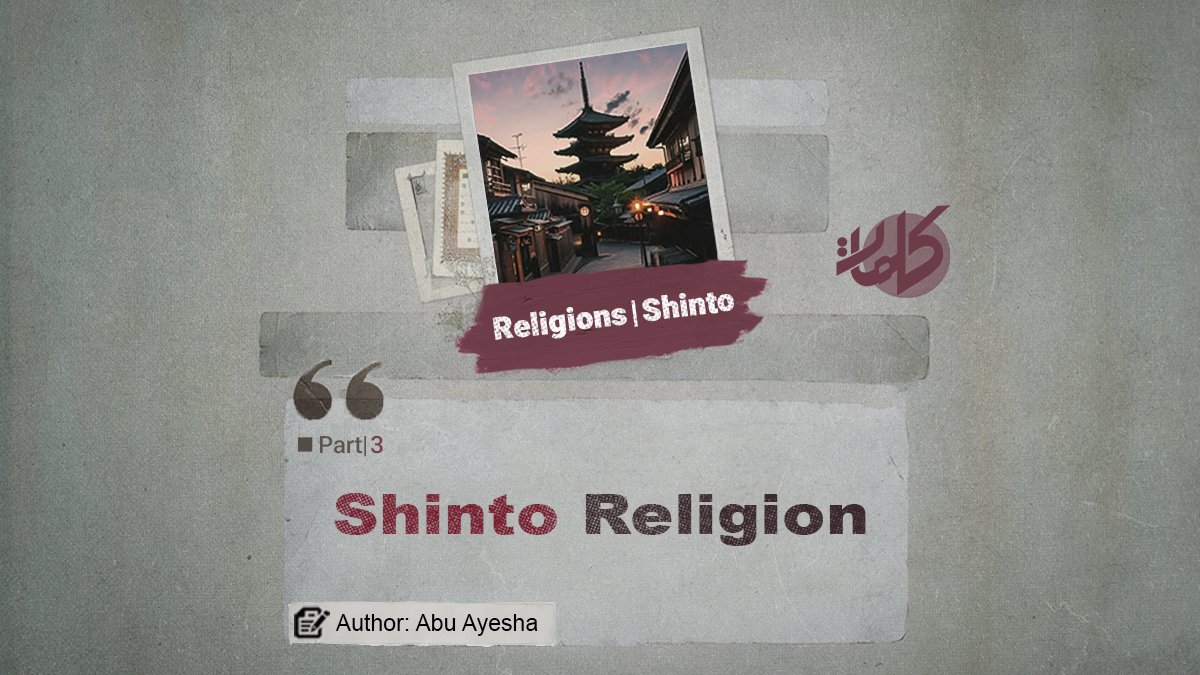Author: Abu Ayesha
Shinto Religion (Part 3)
Introduction:
When studying past religions and their fabricated, hollow beliefs, one realizes even more the heavenly origin, purity, and untainted nature of Islam. A religion in which all rules and laws are clearly defined, and in which the servants of Almighty Allah worship one Lord and are commanded to devote themselves solely to Him. In the fundamental laws of Islam, there is neither change nor alteration. The guidance of Islam applies equally to all: from the greatest ruler to the smallest member of society, all were to submit before the law of Allah. In Shinto and other such faiths, however, one can observe contradictions, irrationality, and empty beliefs.
Transformations in the Shinto Faith
The name of this faith in Japanese was Kami no Michi, meaning “the way of the gods.” Later, the Chinese referred to it as Shinto, which in Chinese also meant “the way of the gods,” and through them this name entered into European languages. After the arrival of Buddhism in Japan, Shinto faced great pressure, to the extent that Shinto priests gradually became confined to a hereditary circle, passing on their position from generation to generation. They began imitating Buddhist temples by constructing Shinto shrines. Worship was conducted in them, and ceremonies were carried out with offerings and supplications, gradually giving Shinto a more organized form.[2]
The word Shinto first appeared in the book Nihongi or Nihon Shoki, which referred to particular rites of the Kami.[3]
Over the centuries, the Japanese people never fully embraced any single religion or faith from among the many that reached their land. What they accepted was a blend of ancient Shinto traditions and Buddhist practices, at times mixed with the moral teachings of Confucianism. In 1868, when the real power of the country fell into the hands of the son of the Sun Goddess, Emperor Mikado of Japan, ancient Shinto was declared the official religion of the country, and Buddhist institutions were separated from the state.[4][5]
The Social Background of the Shinto Faith
As previously mentioned, most of the Japanese people were not originally native to the region. They had migrated from all directions to the Japanese islands, forming a mix of various ethnicities. In such a land, where many tribes and groups gathered, diversity of beliefs was inevitable.
“The Japanese people are composed of various elements. Some originated from Korea, some from Mongol ancestry, and others from Malay roots. The ancestors of these groups migrated over time from Asia or southern oceanic islands to Japan, driving the semi-wild native tribe called Ainu to the north and settling in their place. The ancient social organization of the Japanese was apparently a combination of scattered clans and tribes, each enjoying some degree of independence and possessing its own traditions and beliefs.”[7]
In its broader sense, Shinto is more than a religion. It is actually a fusion of spirits, attitudes, ideas, and practices which, over more than two thousand years, gradually became the essential way of life for the Japanese people. Thus, Shinto is both a personal belief in the Kami and a communal lifestyle shaped in harmony with the concept of the Kami. Over the centuries, it blended with cultural and ethnic influences, both native and foreign, leading to the unification of Japan under imperial rule.[6]
Their religion consisted of a mixture of reverence for natural phenomena and absolute obedience to chiefs and rulers. Magic, taboos, and belief in very simple religious principles took deep root in that primitive society. For example, the fox was considered the messenger of celestial gods and was worshiped. Likewise, the bow and arrow were regarded as a sacred fetish and worshiped as symbols of the gods. The constant warfare with the wild Ainu tribes made fighting and military valor a regular part of daily life in ancient Japan.[8]
It is said that around the first century BCE, three major social centers existed in the country: one in the southwest on Kyushu Island, another on the western coast of the main island of Izunio, and the third in Yamato in the far north. In Kyushu, tribal customs involved worship of multiple gods. In Izunio, people worshiped the harmful storm god Susanoo. In Yamato, local tribes worshiped the Sun Goddess as the sovereign of the heavens and the ancestor of their kings, claiming descent from the sun. Gradually, these three centers formed the foundation of Shinto.[8]
Shinto remained the state religion until 1945, when Japan was subjected to atomic bombing and occupied by the United States. From then on, Shinto practices became voluntary.[9]
Some Religious Customs and Traditions of the Japanese People
Since the Japanese have never adhered to a single unified religion, some are secular, others Buddhist, some Shinto, and a minority Christian. Among them, numerous customs and traditions can be observed. Here, we will focus on Shinto-related customs.
The ancient Japanese, although living in primitive conditions, always had a strong inclination toward personal cleanliness and bodily purity. For instance, when a family member passed away, all members considered themselves defiled and impure. After burying the deceased and observing ten days of mourning, they would all bathe and purify themselves. Often, the surviving family members abandoned the deceased’s home and built a new one for themselves.
The emperors and rulers of ancient times were particularly strict about this. After the death of a ruler, his successor would completely abandon the royal palace and capital of the deceased and construct a new palace in another city, thereby disrupting the entire governmental and social system.[10]
Continues…
Previous Part/ Next Part
References
[1] A detailed discussion of shrines, their types, and the manner of worship in them will be presented later, God willing.
[2] Kojiki, the sacred book of Shinto, trans. Dr. Ehsan Moqaddas, 1st ed., Winter 1380 SH, p. 17.
[3] Japanese Culture, authored by several anthropologists and cultural thinkers; article by Hamideh Amiri Yazdani, n.d., p. 110.
[4] Abdullah Moballeghi Abadani, History of Religions and World Faiths, vol. 1, n.d., p. 113.
[5] John Noss, Man’s Religions (Tarikh-e Jameʿ Adyan), trans. Ali Asghar Hekmat, 3rd ed., 1354 SH, Franklin Publishing Institute, p. 280.
[6] Institute of Media and Cultural Studies weblog, article: “Introduction to Shinto Myths,” published 2024 CE.
[7] John Noss, Man’s Religions, trans. Ali Asghar Hekmat, 3rd ed., 1354 SH, Franklin Publishing Institute, pp. 280–281.
[8] Ibid., p. 281.
[9] Hossein Tofighi, Introduction to Major Religions, n.d., Islamic Sciences World Center, p. 37.
[10] John Noss, Man’s Religions, trans. Ali Asghar Hekmat, 3rd ed., 1354 SH, Franklin Publishing Institute, p. 281.



